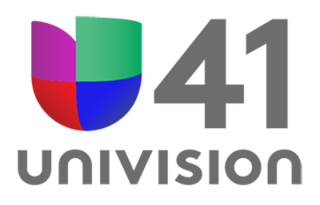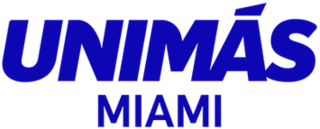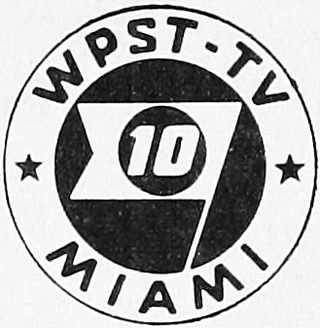
WSVN is a television station in Miami, Florida, United States, affiliated with the Fox network. Serving as the flagship station of locally based Sunbeam Television, it has studios on the 79th Street Causeway in North Bay Village and a transmitter in Miami Gardens, Florida.

KMEX-DT is a television station in Los Angeles, serving as the western flagship station of the Spanish-language network Univision. It is owned and operated by TelevisaUnivision alongside Ontario, California–licensed UniMás station KFTR-DT. The two stations share studios on Center Drive in Westchester; KMEX-DT's transmitter is located atop Mount Wilson.

WPLG is a television station in Miami, Florida, United States, affiliated with ABC. The station is owned by Berkshire Hathaway as its sole broadcast property. WPLG's studios are located on West Hallandale Beach Boulevard in Pembroke Park, and its transmitter is located in Miami Gardens, Florida.

WXTV-DT is a television station licensed to Paterson, New Jersey, United States, serving as the Univision outlet for the New York City area. It is one of two flagship stations of the Spanish-language network. WXTV-DT is owned and operated by TelevisaUnivision alongside Newark-licensed UniMás outlet WFUT-DT and Smithtown, New York–licensed True Crime Network affiliate WFTY-DT. The stations share studios on Frank W. Burr Boulevard in Teaneck, New Jersey; WXTV-DT and WFUT-DT share transmitter facilities at the Empire State Building in Midtown Manhattan.
WFOR-TV, branded CBS Miami, is a television station in Miami, Florida, United States, serving as the market's CBS outlet. It is owned and operated by the network's CBS News and Stations division alongside WBFS-TV, an independent station. The two stations share studios on Northwest 18th Terrace in Doral; WFOR-TV's transmitter is located in Andover, Florida.

WBFS-TV is an independent television station in Miami, Florida, United States. It is owned by the CBS News and Stations group alongside WFOR-TV, a CBS owned-and-operated station. The two stations share studios on Northwest 18th Terrace in Doral; WBFS-TV's transmitter is located in Andover, Florida.

WAMI-DT is a television station licensed to Hollywood, Florida, United States, serving as the Miami-area outlet for the Spanish-language network UniMás. It is owned and operated by TelevisaUnivision alongside Univision station WLTV-DT. The two stations share studios known as "NewsPort" on Northwest 30th Terrace in Doral; WAMI-DT's transmitter is located in Pembroke Park, Florida.

WTVX is a television station licensed to Fort Pierce, Florida, United States, serving the West Palm Beach area as an affiliate of The CW. It is owned by Sinclair Broadcast Group alongside CBS affiliate WPEC and two low-power, Class A stations: MyNetworkTV affiliate WTCN-CD and TBD owned-and-operated station WWHB-CD. The stations share studios on Fairfield Drive in Mangonia Park ; WTVX's transmitter is located southwest of Palm City, Florida.
KUVS-DT is a television station licensed to Modesto, California, United States, broadcasting the Spanish-language Univision network to the Sacramento area. It is owned and operated by TelevisaUnivision alongside Stockton-licensed UniMás outlet KTFK-DT. The two stations share studios on Arden Way near Cal Expo in Sacramento; KUVS-DT's transmitter is located near Valley Springs, California.

WTVJ is a television station in Miami, Florida, United States, serving as the market's NBC outlet. It is owned and operated by the network's NBC Owned Television Stations division alongside Fort Lauderdale–licensed WSCV, a flagship station of Telemundo. The two stations share studios on Southwest 27th Street in Miramar; WTVJ's transmitter is located in Andover, Florida.

WPBF is a television station licensed to Tequesta, Florida, United States, serving the West Palm Beach area as an affiliate of ABC. Owned by Hearst Television, the station maintains studios on RCA Boulevard in the Monet section of Palm Beach Gardens and a transmitter in Palm City southwest of I-95.

WSCV is a television station licensed to Fort Lauderdale, Florida, United States, serving as the Telemundo outlet for the Miami area. It is one of two flagship stations of the Spanish-language network. WSCV is owned and operated by NBCUniversal's Telemundo Station Group alongside NBC station WTVJ. The two stations share studios on Southwest 27th Street in Miramar; WSCV's transmitter is located in Pembroke Park, Florida. The station also serves as the de facto Telemundo outlet for the West Palm Beach market, as that area does not have a Telemundo station of its own.

WLRN-TV is a secondary PBS member television station in Miami, Florida, United States. It is owned by the Miami-Dade County Public Schools district alongside NPR member WLRN-FM (91.3); the two outlets are operated under a management agreement by Friends of WLRN, the stations' fundraising arm. Both stations share studios on Northeast 15th Street and Northeast 1st Avenue in Miami, while WLRN-TV's transmitter is located at McTyre Park in Miami Gardens.

Sunbeam Television Corporation is a privately held broadcasting company based in Miami, Florida, that owns three television stations in the United States. Since the company's founding in 1953, it has been under the control of the Ansin family.

WAQI is a commercial radio station licensed to Miami, Florida, United States, featuring a Spanish-language talk format known as Radio Mambí. Owned by Latino Media Network and formerly operated by Uforia Audio Network, the radio division of TelevisaUnivision, under a transitional agreement, the station broadcasts with 50,000 watts and serves as South Florida's designated primary entry point for the Emergency Alert System, one of three in the state. The studios are located at Univision's Miami headquarters, and the transmitter is located at the intersection of U.S. 41 and Florida State Road 997, near the edge of the Everglades.
WGBS-TV was a television station that broadcast on channel 23 in Miami, Florida, United States, from 1953 to 1957. Originally established as WFTL-TV in Fort Lauderdale, it moved south to Miami when it was purchased by Storer Broadcasting at the end of 1954 and consolidated with a construction permit Storer bought for a Miami station.
Media in Miami, Florida, United States, includes newspapers, magazines, Internet-based web sites, radio, television, and cinema. Florida produces some of its own media, while some comes from outside the state for Floridian consumption.
On January 1, 1989, six television stations in the Miami–Fort Lauderdale and West Palm Beach, Florida, markets, exchanged network affiliations. The event, referred to in contemporary media coverage as "The Big Switch", was described as "Miami's own soap opera" and at times compared to Dallas and Dynasty because of the lengthy public disputes between multiple parties that preceded it. Approximately three million television viewers in both markets were affected.
WITV was a television station that broadcast on channel 17 in Fort Lauderdale, Florida, United States. Owned by the Gerico Investment Company, it was the third television station on the air in the Miami–Fort Lauderdale area and the fourth in South Florida, operating from December 1953 to May 1958. It was doomed by troubles that plagued ultra high frequency (UHF) television in the days before the All-Channel Receiver Act and particularly the arrival of two additional VHF TV stations to Miami in 1956 and 1957. The WITV transmitter facility was purchased by the Dade County School Board, eventually resulting in the reactivation of channel 17 as Miami-based WLRN-TV in 1962.

WPST-TV was a television station that broadcast on channel 10 in Miami, Florida, United States, for four years, from 1957 to 1961. Launched as the third commercially licensed very high frequency (VHF) station in Miami and the market's second American Broadcasting Company (ABC) affiliate after WITV (channel 17), it was owned by Public Service Television, Inc., the broadcasting subsidiary of Miami-based National Airlines (NAL), and managed by NAL founder/CEO George T. Baker. It was the first television station in the United States to have its broadcast license revoked by the Federal Communications Commission (FCC).














